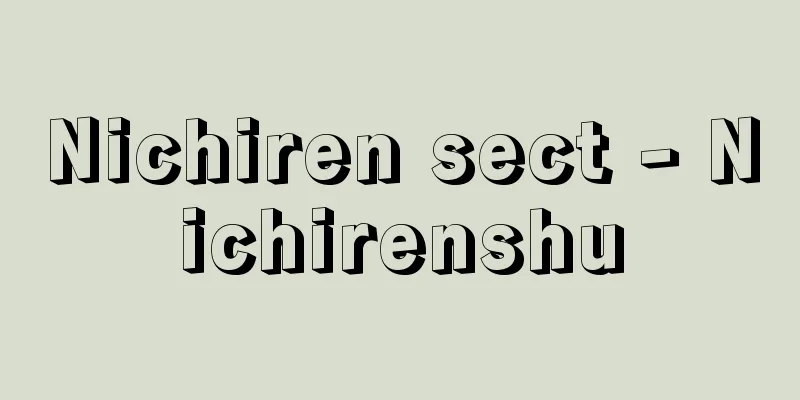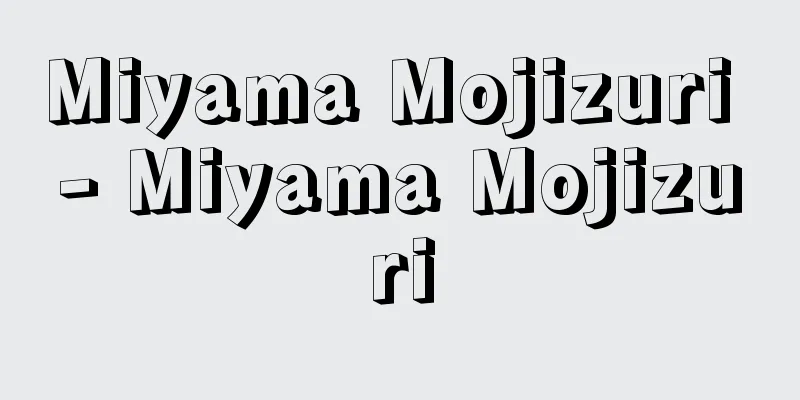Nichiren sect - Nichirenshu

|
A religion founded by Nichiren in the mid-Kamakura period. It was called Hokkeshu (Landscape sect) because it placed its faith solely in the Lotus Sutra (Hokekyo), but at the end of the Azuchi-Momoyama period it came to be called Nichiren Hokkeshu (Nichiren sect) or Nichiren sect to distinguish it from Tendai Hokkeshu (Tendai sect). [Endo Asai] historyThe history of Nichiren's founding and deathThe date of the founding of the sect is considered to be April 28, 1253 (Kencho 5), when Nichiren chanted "Namu Myoho Renge Kyo" for the first time at Seicho-ji Temple in Awa Province (Chiba Prefecture). After incurring the wrath of the local lord Tojo Kagenobu, who was a believer in Nembutsu, Nichiren was driven out of Kiyosumi and went to Kamakura, where he repeatedly preached in the streets, but the area was plagued by frequent storms, fires, earthquakes, famines and epidemics, and in particular the earthquake in August 1257 (Shoka 1) destroyed Kamakura. As a Buddhist, Nichiren could not bear to watch this terrible situation, so he used Buddhist scriptures to explain the origin of the disaster and how to eradicate it. He called it "Rissho Ankoku Ron" and submitted it to the former regent, Hojo Tokiyori, on July 16, 1260 (Bun'o 1). In it, he predicted civil war and foreign invasions, and specified Honen Nembutsu as an evil teaching that would destroy the country. After that, Nichiren suffered numerous persecutions, all of which were rooted in "Rissho Ankoku Ron." The month after the offering, a group of Nembutsu followers burned down Matsubayashi Soan (Nichiren's temple), and from May 1261 (Kōchō 1) to February 1263, he was exiled to Ito in Izu (now Butsugenji Temple), and in September 1264 (Bun'ei 1), he returned to his hometown to visit his seriously ill mother, and on November 11, he was ambushed by the soldiers of Jito (Lord) Tojō Kagenobu on Matsubara-ōji in Tojō-go, killing one disciple and one follower, and Nichiren himself was wounded in the forehead. Meanwhile, letters from the Mongols urging Japan to surrender were sent repeatedly in 1268 and 1269, and the situation became increasingly tense, and Nichiren's movement to establish the correct teaching and bring peace to the country also became more and more intense. On September 12, 1271, he was sentenced to beheading at Tatsunoguchi Execution Ground (now Ryukoji Temple) across from Enoshima, but miraculously escaped and was immediately exiled to Sado Island, where he was pardoned in March 1274. The mental pressure of the persecution was great, and each time he was exiled he would check the text of the Lotus Sutra, deepening his awareness of himself as a practitioner of the Lotus Sutra. Until the age of 50, Nichiren based his teachings in Kamakura and preached in Suruga and Boso, then lived in Sado until the age of 53 and at Mount Minobu (Kuonji Temple) until the age of 61, where he preached in writing and encouraged his disciples to establish a base for his religious organization in Kai and Suruga. He passed away on October 13, 1282 (Kōan 5) at Honmonji Temple in Ikegami, Musashi Province. [Endo Asai] The formation of sectsAt the time of Nichiren's death, he appointed Nissho, Nichirou, Nikko, Hinata, Niccho, and Nichiji as his principal disciples (the Six Elders), and was buried in Minobu according to his will. On the 100th day after his death in January the following year, a monthly rotation table was established for the 18 members of the Six Elders to take turns offering incense and flowers at the ancestral shrine. Each member devoted themselves to missionary work in a place connected to them, and also served as a rotation in Minobu during the designated months. However, around the time of the third anniversary of his death, Nikko was the sole resident at the ancestral shrine and served as attendant, but after he admonished the feudal lord, Hakii Sanenaga, for his impure faith, in 1288 (Shoo 1), Nikko established Taiseki-ji and Honmon-ji temples at the foot of Mount Fuji in Suruga. This was the first branch of the Fuji sect and the origin of the Fuji sect. Nikko had 12 disciples, including Honroku and Shinroku, and spread his teachings from Kai, Suruga, and Izu in the east to Oshu in the west and Shikoku and Kyushu in the west. Nichison (1265-1345) in particular is said to have built 36 temples, including Jogyo-in (later Yobo-ji) in Kyoto. After the death of Nichimoku, a senior disciple of Nichiren Buddhism, conflicts arose among the disciples, and the eight main temples of the Nichiren sect split into two or three schools by the Meiji era. At one point they united and officially called themselves the Honmon sect, but in 1900 (Meiji 33), the Taisekiji sect separated from the Honmon sect and called itself the Nichiren sect Fuji sect, and in 1913 (Taisho 2), they took the name Nichiren Shoshu. The Nichisho monryu (Hamamonryu) inherited its teachings at Hokkeji Temple in Hamado, Kamakura (which was founded by Nichisho and later moved to Tamasawa, Izu), and Myohoji Temple in Murata, Echigo Province. Nichirou's main temples were Myohon-ji in Hikigayatsu, Kamakura, Honmon-ji in Ikegami, Musashi Province, and Hondo-ji in Hiraga, Shimousa Province. Nichirou's disciples Kuho, especially Nichizo, were pioneers in the spread of Buddhism in Kyoto, founding Myoken-ji in Shijo (Shijo school). Nichiin (1264-1328) succeeded Honsho-ji in Kamakura and founded Honjo-ji in Echigo Province. His disciple Nichijo (1298-1369), under the patronage of Ashikaga Takauji, moved Kamakura's Honsho-ji to Rokujo, Kyoto, and established Honkoku-ji (later Honkoku-ji) (Rokujo school). Hyuga lived at Myoko-ji Temple (now Sogen-ji Temple) in Mobara, Kazusa Province, but after Nikko left the temple he came to reside in Minobu, and so his teachings are called the Minobu school. Nichicho was in charge of Gubo-ji Temple in Mama, Kazusa Province, but after being expelled and joining the sect of Nikko, he took charge of it along with Wakamiya Hokkedo (later known as Nakayama Hokkeji Temple), which his father-in-law Nichijo (1214-1299) had turned into a temple in his own home. The teachings were called the Nakayama school, and Nichiyu (1298-1374), who succeeded him, expanded the influence of the sect with the patronage of the Chiba clan, enriched the "Nichiren writings" that Nichijo had collected, and built Kosho-ji Temple in Ogi, Hizen Province, laying the foundation for the spread of Buddhism in Kyushu. The above five elders (including Nichiji) sects, excluding Nikko, belong to the Nichiren sect in the narrow sense (single-named Nichiren sect) centered on Mount Minobu, and in terms of doctrine, they are called the Ichi school in contrast to the Shorei school of the Nichiko sect. The Ichi school and Shorei school refer to the first 14 chapters of the 28 chapters of the Lotus Sutra as Shakumon and the last 14 chapters as Honmon, and while the Shomon school focuses on the theory of the Buddha nature of the two vehicles becoming Buddhas, the Honmon school explains the karma between Shakyamuni (Shaka), who attained enlightenment in the distant past, and all living beings. The Unity school argues that since both Honshu and Takuji are part of the same sutra, they are ultimately the same in terms of principle (one thought contains three thousand things), whereas the Superiority and Inferiority school disagrees, arguing that if they were the same, it would be the same as Tendai Buddhism, and argues that even in terms of principle, there are differences between Honshu and Takuji. However, in the early Muromachi period, Nichiju split off from the 4th Chuzan Nichison and founded Myoman-ji Temple in Kyoto (Myoman-ji school, Kenpon Hoke sect), while Nichiden and Nichijin, disciples of Nissei of Honkoku-ji Temple, fought over the consistency and superiority of the original and traced works, and Nichijin, who was based at Honjo-ji Temple in Echigo Province, claimed superiority and split off from the Rokujo school to found Honzen-ji Temple in Kyoto (Honjo-ji school, Hoke sect). Nichiryu, who also insisted on superiority and inferiority, was not satisfied with the behavior of Gatsumyō, the 5th abbot of Myoken-ji Temple, and founded Honno-ji Temple in Kyoto and Honko-ji Temple in Amagasaki, becoming independent from the Shijo school (Happonha, Honmon Hokke sect). In the mid-Muromachi period, Nisshin (1444-1528), who also insisted on superiority and inferiority, became independent from Nichigu, the 6th abbot of Myoken-ji Temple, and founded Honryū-ji Temple in Kyoto (Honmyohokke sect). Broadly speaking, the various Nichiren sects are divided into those that insist on superiority and inferiority and those that insist on unity. In the early Edo period, Nichiō's Fujufuseha sect split off, but this was a difference of opinion on etiquette, and his teachings belonged to the unity sect. In turn, during the Tenbun Rebellion in 1536 (Tenbun 5), the 21 great temples in Kyoto were burned down and Mount Hiei was burned down, and in the Azuchi Debate with the Jodo sect in 1579 (Tensho 7), the sect was oppressed by Oda Nobunaga, and in the Osaka Debate in 1599 (Keicho 4), Tokugawa Ieyasu strictly forbade the sect from not accepting or giving truth.After this, the sect's shakubuku-oriented teachings gradually softened and the sect was able to maintain its existence by adapting to the feudal system. In addition, Honmon Butsuryushu sect split off from Honmon Hokkeshu at the end of the Edo period by Nagamatsu Nissen, and in recent times lay religious groups such as Reiyukai, Rissho Kosei-kai, and Soka Gakkai have become popular. [Endo Asai] DoctrineWhile the Japanese Tendai sect studied the Lotus Sutra, Shingon Buddhism, and Pure Land Buddhism, the Nichiren sect exclusively studied the Lotus Sutra, and while the former followed the Trace Gate in the Lotus Sutra, the latter followed the True Gate. This is because, in light of the five principles of religion, namely, teaching (the shallowness or depth of the law), capacity (whether one's roots can bear it), time (whether it is appropriate for the time or not), country (whether it is in keeping with the times), and procedure (the order in which the Buddhist law is spread), the True Gate Lotus Sutra had to be chosen. [Endo Asai] The five rulesThe Five Principles were devised in 1262 during Nichiren's exile to Ito as necessary precautions for the propagation of the Lotus Sutra, but initially the belief in the True Teaching had not yet been established. However, around the time of his exile to Sado, the teachings on the Honmen-jakuura system were established as part of the teachings, and it was said that the great medicine to cure the extremely serious illness of the Latter Day of the Law (the Jikko system) must be the True Teaching of the Lotus Sutra, and that the great teaching that must be spread after the Jikko system of the Lotus Sutra of Tendai (the Joko system) is the True Teaching of the Lotus Sutra, in other words, "Namu Myoho Renge Kyo," the True Teaching that Shakyamuni has possessed since time immemorial. [Endo Asai] The Three SecretsThe essence of Honmon is called the Three Mysteries of the Sect, which are the three great secrets of the Gohonzon, the Daimoku, and the Kaidan. The principal image is the Buddha Shaka, the founder of the eternal enlightenment, and the Ten Worlds Mandala is a written depiction of his appearance. The daimoku is the chant "Namu Myoho Renge Kyo" by the practitioner, and by chanting this, all the merits accumulated by Shaka are naturally transferred to us, and we attain Buddhahood in this very body, and after death we are reborn in the Pure Land of Mount Sacred Mountain. The ordination platform is the training ground where practitioners practice the Lotus Sutra, but ultimately it means the Buddha's land (Rissho Ankoku) that must be built in the real world, and this is the ultimate ideal. To realize this ideal, monks and laypeople must work together to educate those who have not believed, endure any persecution as a sign of self-respect in the Lotus Sutra, and rejoice in it as repentance and elimination of sins. Since the Meiji period, some have interpreted Nichiren's idea of establishing a peaceful nation through correct teaching as a nationalistic one, but since the true meaning of the idea was that of the bodhi mind of a practitioner of the Lotus Sutra, this is a misinterpretation that caters to the times. [Endo Asai] OrganizationThe head temple is Kuonji Temple on Mount Minobu. The head priest of Kuonji Temple is called Hossu (Hoshu), and is responsible for all religious matters of the Nichiren sect. The Nichiren sect also has an organizational structure, the Nichiren Shu Soumuin (Ikegami, Tokyo), which oversees all temples and teachers nationwide, and under it are the various Soumu offices in 74 districts across the country. At the top of these are the Chief Abbot (the 49th as of 2000) and the General Director of Soumu, who oversee the affairs of the temple, and under them are the General Planning Department, General Affairs Department, Finance Department, Educational Affairs Department, Law Protection and Mission Department, Institute for Contemporary Religion, Kangakuin, and the Nichiren Shu Newspaper Company. Each regional Soumu office has a Director of Soumu office who liaises with the central government. As for the main dojo-related facilities, those who have been ordained are issued their ordination certificates four times a year at Seichoji Temple in Kominato, Kamogawa City, Chiba Prefecture. To study and qualify as a soryo, one must enter the Shingyo dojo in Minobu, Yamanashi Prefecture, and practice the two necessary practices of practice and study for 35 days. Those who wish to become a shūhōshi (priests of Buddhist monks) enter the Daiaragyōdō hall at Nakayama Hokekyoji Temple in Chiba Prefecture, and practice prayer rituals for 100 days from November 1st. There are also schools recognized by the Ministry of Education, Culture, Sports, Science and Technology, such as Minobusan University on Mount Minobusan and Rissho University in Osaki, Shinagawa Ward, Tokyo, and graduates are given the rank of a monk equivalent to the qualifications of a chief priest. As for other schools, Soka University is located in Hachioji City, Tokyo, but it does not have a Buddhist studies department. The history of overseas missionary work dates back to 1295 (Einin 3) when Nichiren's direct disciple Nichimochi left Matsuno in Suruga Province (Shizuoka Prefecture) and preached in Tohoku and Hokkaido, traveling to faraway Mongolia, where he is said to have died, but there is no definitive proof that he did so. In more recent times, the 48th abbot of Kyoto Honkokuji Temple, Asahi Nichimyo (1833-1916), aspired to overseas missionary work and formed the Overseas Missionary Society, which established temples in Korea, Taiwan, Karafuto (Sakhalin), and Manchuria (northeastern China), but was dissolved after Japan's defeat in World War II. As of 2000, there are 13 Nichiren sect temples overseas in the United States (5 of which are in Hawaii), 1 in Canada, 1 in the United Kingdom, 1 in Germany, 1 in South Korea, 1 in Sri Lanka, 1 in India, and 4 in Brazil. [Endo Asai] "Nichiren Sect Reader" and "Complete History of the Nichiren Sect" edited by Nichiren Doctrine Research Institute, Rissho University (1961, Heirakuji Shoten)" ▽ "The Establishment and Development of the Nichiren Sect, by Nakao Takashi (1973, Yoshikawa Kobunkan)" ▽ "Nichiren Sect Dictionary" edited by Nichiren Sect Headquarters (1981, Tokyodo Publishing)" ▽ "Chronology of the Modern Nichiren Sect, edited by Nichiren Sect Institute of Contemporary Religion (1981, Dohosha)" ▽ "Dictionary of Saint Nichiren's Writings: Historical Edition" edited by Nichiren Doctrine Research Institute, Rissho University (1985, Sanseido)" ▽ "Reader of the Outline of the Doctrine of the Sect, edited by Nichiren Sect Kangakuin (1989, Nichiren Sect Newspaper Company)" [References] | | | | Temple| | | |Namu Kyo| | | | | | | | | | |Honmonji | | |Rissho kai|Reiyu©Shogakukan "> Nichiren sect / Brief family tree This is the head temple of the Nichiren sect. It was founded in 771 (Hōki 2) when Fushigi-bōshi carved and enshrined the Kokuzo Bosatsu, and is said to have been rebuilt by Jikaku Daishi Ennin in 836 (Jowa 3). The 1,000-year-old cedar tree in the temple grounds is a nationally designated natural monument, and the inner gate, stone pagoda, and temple bell are all designated as tangible cultural properties of the prefecture. Kamogawa City, Chiba Prefecture © Chiba Prefecture Tourism and Products Association "> Seichoji Temple The head temple of the Nichiren sect at the foot of Mt. Minobu. It began when Saint Nichiren entered Mt. Minobu in 1274 (Bun'ei 11). In 1474 (Bunmei 6), the Nichijo constructed a large temple at the current location. In the background of the photo is the main hall, which was rebuilt in 1985 (Showa 60). Minobu Town, Minamikoma District, Yamanashi Prefecture © Yamanashi Tourism Organization "> Kuonji Temple Source: Shogakukan Encyclopedia Nipponica About Encyclopedia Nipponica Information | Legend |
|
鎌倉中期に日蓮によって開かれた宗教。もっぱら『法華経(ほけきょう)』を帰依(きえ)の対象にするので法華宗(ほっけしゅう)と称していたが、安土桃山(あづちももやま)時代の末期には天台法華宗(天台宗)と区別するため、日蓮法華宗、日蓮宗といわれるようになった。 [浅井円道] 歴史開宗と日蓮入滅までの経緯1253年(建長5)4月28日、安房国(あわのくに)(千葉県)の清澄寺(せいちょうじ)で初めて「南無妙法蓮華経(なむみょうほうれんげきょう)」を日蓮が唱えたときを立教開宗の日とする。念仏信者であった地頭(じとう)東条景信(とうじょうかげのぶ)の怒りに触れて清澄(きよすみ)を追われ、鎌倉に出た日蓮は街頭布教を繰り返していたが、暴風、大火、地震、飢饉(ききん)、疫病がしきりで、ことに1257年(正嘉1)8月の地震は鎌倉を破壊した。仏者としてこの惨状を黙視するに忍びず、仏典によって災難興起の由来と退治の方法を考え出し、『立正安国(りっしょうあんこく)論』と名づけて1260年(文応1)7月16日、前執権北条時頼(ほうじょうときより)に上奏した。そのなかには内乱・外寇(がいこう)の予見があり、また亡国の邪法として法然念仏(ほうねんねんぶつ)を指定している。以後、日蓮は数々の迫害を受けるが、それはすべて『立正安国論』に由来する。献上の翌月には念仏者の集団による松葉谷草庵(まつばがやつそうあん)(自坊)の焼打ち、翌年の1261年(弘長1)5月から1263年2月までは伊豆の伊東に流罪(いまの仏眼寺(ぶつげんじ))、1264年(文永1)9月のころ母の重病を見舞うために故郷に帰り、11月11日東条郷の松原大路で地頭東条景信の伏兵の刀難にあい、弟子1人、信者1人は討ち死にし、日蓮も眉間(みけん)に刀傷を受けた。一方、日本に降伏を勧める蒙古(もうこ)の牒状(ちょうじょう)が1268年、1269年と繰り返しきて、風雲はいよいよ急を告げ、したがって日蓮の立正安国の運動もまたいよいよ激化した。そして1271年9月12日江の島の対岸の竜口刑場(たつのくちけいじょう)(いまの竜口寺(りゅうこうじ))にて斬首(ざんしゅ)の科刑にあったが、不思議にも難を逃れ、その場からただちに佐渡流罪となり、1274年3月赦免となる。迫害が与える精神的重圧は大きく、日蓮はそのたびごとに『法華経』の文にこれを照合し、「法華経の行者」日蓮の自覚を深めた。日蓮は50歳までは鎌倉を本拠として駿河(するが)、房総に布教し、53歳までは佐渡、61歳までは身延山(みのぶさん)(久遠寺(くおんじ))に住して諸方に文書伝道し、弟子らを督励して甲斐(かい)、駿河にも教団の地盤を築いていった。1282年(弘安5)10月13日武蔵国(むさしのくに)池上(いけがみ)(本門寺)で入滅。 [浅井円道] 分派の形成日蓮は入滅のとき、日昭(にっしょう)、日朗(にちろう)、日興(にっこう)、日向(にこう)、日頂(にっちょう)、日持(にちじ)を本弟子(六老僧)と定め、遺言により身延に埋葬された。翌年正月の百日忌には六老僧らの計18人が交替で祖廟(そびょう)に香華(こうげ)する月割当番(輪番)表を制定し、各自は有縁の地で布教に励むとともに、所定の月には身延の輪番に服した。しかし三回忌の前後にはもっぱら日興が常住して祖廟給仕の任にあたったが、領主の波木井実長(はきいさねなが)の信仰に不純ありといさめて、1288年(正応1)離山、駿河の富士山麓(さんろく)に大石寺(たいせきじ)、本門寺を創建した。これが初度の分派で、富士門流形成の起源である。日興の門下に本六(ほんろく)、新六(しんろく)の12人をはじめとする弟子があり、甲斐、駿河、伊豆を中心として、東は奥羽から西は四国・九州までも教線を伸ばし、とくに日尊(にちぞん)(1265―1345)は京都の上行院(じょうぎょういん)(後の要法寺(ようぼうじ))など36寺を建立したといわれる。日興の高弟日目(にちもく)の滅後、門下に対立が生じ、興門の八箇本山は二流三流に分かれて明治時代に至り、いったんは大同団結して本門宗を公称したが、1900年(明治33)大石寺派は本門宗から独立して日蓮宗富士派と称し、1913年(大正2)には日蓮正宗(しょうしゅう)を名のった。 日昭門流(浜門流(はまもんりゅう))は、日昭建立の鎌倉浜土(はまど)の法華寺(のち伊豆玉沢(たまさわ)に移転)、越後国(えちごのくに)村田の妙法寺で法類を相続した。 日朗門流は、鎌倉比企谷(ひきがやつ)の妙本寺、武蔵国池上の本門寺、下総国(しもうさのくに)平賀(ひらが)の本土寺を本寺とし、日朗弟子の九鳳(くほう)、なかでも日像(にちぞう)は京都開教の先駆者となって四条に妙顕寺を創立し(四条門流)、日印(1264―1328)は鎌倉の本勝寺を継ぎ、越後国に本成寺(ほんじょうじ)を創立した。その弟子日静(にちじょう)(1298―1369)は足利尊氏(あしかがたかうじ)の外護(げご)で鎌倉本勝寺を京都六条に移して本国寺(のち本圀寺(ほんこくじ))をおこした(六条門流)。 日向は上総国(かずさのくに)茂原(もばら)の妙光寺(いまの藻原寺(そうげんじ))に住したが、日興の離山ののちは身延に常住することになったから、その法類を身延門流という。 日頂は上総国真間(まま)の弘法寺(ぐぼうじ)を管したが、排斥されて日興の門に投じてのちは、義父の日常(にちじょう)(1214―1299)が自邸を寺とした若宮法華堂(後の中山法華経寺)とともに管理。その法類を中山門流とよび、次々代の日祐(にちゆう)(1298―1374)は千葉氏の外護を得て教勢を伸ばし、日常が収集した「日蓮遺文」を充実し、肥前国の小城(おぎ)に光勝寺を建立して、九州開教の基を築いた。 日興以外の、以上五老(日持を加えて)の門流は身延山を中心とする狭義の日蓮宗(単称日蓮宗)に属し、教理上では日興門流の勝劣派に対して一致派とよぶ。一致・勝劣とは、『法華経』28品(ほん)の前14品を迹門(しゃくもん)、後14品を本門(ほんもん)とよび、迹門は二乗作仏の仏性理論を中心とするのに対し、本門は久遠成道(くおんじょうどう)の釈尊(しゃくそん)(釈迦(しゃか))と衆生(しゅじょう)との因縁(いんねん)を説く。一致派は、本迹ともに一経の内であるから、所詮(しょせん)の理(一念三千)においては一致であるというのに対し、勝劣派は、一致ならば天台宗と同じになるとしてこれに反対し、所詮の理においても本勝迹劣の相違があると主張した。 しかし、室町初期、日什(にちじゅう)は中山4代日尊から分立して京都に妙満寺を創し(妙満寺派、顕本法華宗(けんぽんほっけしゅう))、本国寺日静の弟子日伝(にちでん)と日陣(にちじん)とは本迹の一致・勝劣を争い、越後国の本成寺に拠(よ)った日陣は勝劣を主張して六条門流から分立し、京都に本禅寺を創した(本成寺派、法華宗)。同じく勝劣を主張する日隆も妙顕寺5代月明(がつみょう)のふるまいに飽き足らず、京都に本能寺、尼崎(あまがさき)に本興寺をおこして四条門流から独立し(八品派(はっぽんは)、本門法華宗)、また室町中期には同じく勝劣を主張する日真(にっしん)(1444―1528)が妙顕寺6代日具から独立して京都に本隆寺を創した(本妙法華宗)。これらを大別すれば、日蓮宗諸派は勝劣派と一致派とに分かれる。江戸初期には日奥(にちおう)の不受不施派(ふじゅふせは)が分立したが、これは行儀上の異見であって、その教学は一致派に属する。 ひるがえって1536年(天文5)天文法難(てんぶんほうなん)(天文法乱)で、京都に21を数えた諸大寺も叡山(えいざん)の焼打ちにあい、1579年(天正7)の浄土宗との安土宗論(あづちしゅうろん)で織田信長に圧迫され、1599年(慶長4)の大坂対論で徳川家康に不受不施義を厳禁されてのちは、宗門の折伏(しゃくぶく)的教風もしだいに軟化し、封建制度に即応して宗門を維持した。なお、本門仏立宗(ほんもんぶつりゅうしゅう)が江戸末期に長松日扇(ながまつにっせん)によって本門法華宗から分かれ、また近時になっては、在家信仰団体としての霊友会、立正佼成会(りっしょうこうせいかい)、創価学会などが盛んである。 [浅井円道] 教理日本天台宗が『法華経』、真言教(しんごんきょう)、浄土教を兼修したのに対して、日蓮宗は『法華経』を専修し、また前者が『法華経』中の迹門によったのに対して後者は本門による。そのわけは、宗教の五義、つまり教(法の浅深)、機(根の堪不(たんぷ))、時(期相応不相応)、国(風にかなうか否か)、序(仏法流布の先後)の五綱に照らすと、本門法華経が必然的に選択されねばならぬからである。 [浅井円道] 五綱五義は1262年、日蓮の伊東流罪中に考え出された法華布教に必要な用心であるが、当初はまだ本門信仰は確立していなかった。しかし佐渡流罪の前後から教綱の一環として本面迹裏の教判が成立すると、末法の極重病(時綱)を治す大良薬は本門法華経でなければならぬ、また天台の迹門法華経の次(序綱)に広められねばならぬ大法は本門法華経、つまり釈尊の久遠以来所持の本法たる「南無妙法蓮華経」であるという。 [浅井円道] 三大秘法本門の肝要を宗旨の三秘といい、本尊、題目、戒壇の三大秘法がこれである。 本尊とは久遠実成(くおんじつじょう)の教主釈迦仏(しゃかぶつ)、その姿を文字に図顕したのが十界曼荼羅(じっかいまんだら)である。題目とは行者が唱える「南無妙法蓮華経」をいい、この唱えによって釈尊が積んだいっさいの功徳(くどく)は自然にわれわれに譲与され、われわれは即身に成仏(じょうぶつ)し、死後は霊山浄土(りょうぜんじょうど)に往生する。戒壇とは行者が『法華経』を修行する道場のことであるが、究極的には現実の娑婆(しゃば)に建設しなければならぬ仏国土(立正安国)を意味し、ここに最終の理想を置く。この理想実現のために、僧俗は一体となって未信の者を教化し、いかなる迫害も『法華経』の身読(しんどく)として甘受し、懺悔滅罪(さんげめつざい)として喜ばねばならぬ。明治以降、日蓮の立正安国思想を国家主義的に解釈する人も出たが、本意は「法華経の行者」の菩提(ぼだい)心の内容であるから、それは時代迎合的な曲解である。 [浅井円道] 組織・機構総本山は身延山久遠寺。久遠寺住職は法主(ほっす)とよばれ、日蓮宗の信仰面を統括する。また一宗の組織としては、全国の寺院・教師を統括する日蓮宗宗務院(東京・池上)が置かれ、その傘下に全国74管区の各宗務所がある。その頂上に管長(2000年現在49代)、宗務総長各1名があって院務を総監し、配下に綜合(そうごう)企画部、庶務部、財務部、教務部、護法伝道部、現代宗教研究所、勧学院、日蓮宗新聞社がある。地方宗務所には宗務所長1名があって、中央との渉にあたる。 主たる道場関係施設としては、得度した者には、年4回千葉県鴨川(かもがわ)市小湊(こみなと)の清澄寺において度牒(どちょう)が交付される。勉学して僧侶(そうりょ)の資格を得るためには山梨県身延山内の信行道場に入り、35日間、必要な行学二道を修行しなければならない。また修法師を志す者は千葉県中山法華経寺の大荒行堂(だいあらぎょうどう)に入り、11月1日から100日間、祈祷(きとう)修法を実習する。また文部科学省公認の学校として、身延山に身延山大学、東京都品川区大崎に立正大学があり、卒業した者には住職資格に相応する僧階が与えられる。他派では創価大学が東京都八王子市にあるが、仏教学部は備えていない。 海外布教の歴史は、早く日蓮直弟子の日持が1295年(永仁3)駿河国(静岡県)松野を出発して東北・北海道から、遠く蒙古(モンゴル)に布教し、その地で果てたといわれるが、蒙古布教の確証はない。近代に京都本圀寺48世旭日苗(あさひにちみょう)(1833―1916)が海外布教を志し、海外宣教会を結成して朝鮮・台湾・樺太(からふと)(サハリン)・満州(中国東北)に開教し実績を残したが、第二次世界大戦の敗戦により消滅した。日蓮宗の海外寺院は、2000年現在、アメリカに13(うちハワイに5)、カナダに1、イギリスに1、ドイツに1、韓国に1、スリランカに1、インドに1、ブラジルに4ある。 [浅井円道] 『立正大学日蓮教学研究所編『日蓮宗読本』『日蓮教団全史』(1961・平楽寺書店)』▽『中尾尭著『日蓮宗の成立と展開』(1973・吉川弘文館)』▽『日蓮宗宗務院編『日蓮宗事典』(1981・東京堂出版)』▽『日蓮宗現代宗教研究所編『近代日蓮宗年表』(1981・同朋舎)』▽『立正大学日蓮教学研究所編『日蓮聖人遺文辞典・歴史編』(1985・三省堂)』▽『日蓮宗勧学院編『宗義大綱読本』(1989・日蓮宗新聞社)』 [参照項目] | | | | | | | | | | | | | | | | | | | | | | |©Shogakukan"> 日蓮宗/略系図 日蓮宗の大本山。771年(宝亀2)に不思議法師が虚空蔵菩薩を刻み安置したのに始まり、836年(承和3)慈覚大師円仁が再興したと伝える。境内にある千年杉は国指定天然記念物、中門、石造宝篋印塔、梵鐘などは県の有形文化財に指定されている。千葉県鴨川市©公益社団法人千葉県観光物産協会"> 清澄寺 身延山の麓にある日蓮宗の総本山。1274年(文永11)日蓮聖人が身延山に入山したのにはじまる。1474年(文明6)日朝により現在地に大伽藍が造営された。写真奥は1985年(昭和60)に再建された本堂。山梨県南巨摩郡身延町©やまなし観光推進機構"> 久遠寺 出典 小学館 日本大百科全書(ニッポニカ)日本大百科全書(ニッポニカ)について 情報 | 凡例 |
<<: Nichiren Shoshu - Nichiren Shoshu
Recommend
Honing machine (English)
...A large amount of low-viscosity oil such as ke...
kero
…A human figure is placed in the center of the bu...
Vernon, E. (English spelling) VernonE
…Rum is also used in cocktails (such as daiquiris...
Norton, Charles Eliot
Born November 16, 1827 in Cambridge, Massachusetts...
Garter (English spelling)
A device for fastening socks. There are those that...
"Imayo Mochizuki" - Imayo Mochizuki
…It is also called “Hanawaka Vengeance.” The othe...
Wisdom of Solomon; Book of Wisdom
It is one of the Apocrypha of the Old Testament. A...
《Journal officiel de l'Empire français》 (English notation) Journalofficiel del Empirefrancais
...The name of the paper at the time of its found...
Areopagus Council - Areopagus Council
The Council of Ancient Athens, equivalent to the R...
Omine 75 Waves - Omine Shichijugo Nabiki
...As practitioners became more organized, Shugen...
Magistrate of the Supreme Court - Ossobugyonin
…Eventually, in 1264 (Bun'ei 1), an instituti...
Lithium Hydroxide - Lithium Suisanka
LiOH (23.95). The monohydrate is obtained from aq...
Ambivalence
Love-hate feelings. Used when an individual's ...
Gatun Locks - Gatunkoumon
" Las esclusas de Gatun " is one of the ...
Law of demand and supply
The idea that the relative price of a commodity is...









